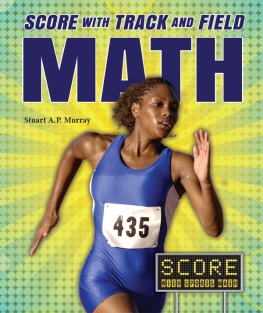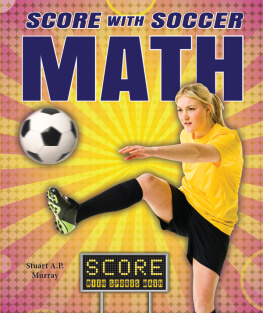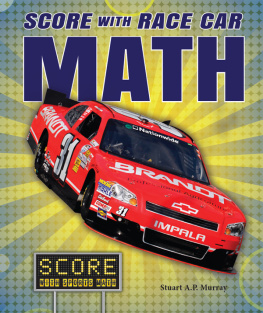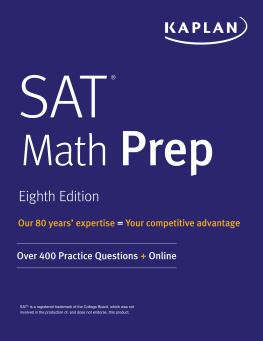LET'S GET OVER THE MATH HURDLE!
Guess what? Lots of math is used in sports! How many points is a field goal? What percent of quarterback passes were intercepted? Even batting averages involve fractions and decimals. So get warmed up and ready to tackle some sports word problems, which include addition, multiplication, division, subtraction, fractions, and decimals. Learn some history and stats about your favorite athletes, too!
"Students often don't see the relevance of classroom math to their world. This series takes them into the exciting world of athletics, showing the direct relationship between the math the students are learning and various sports. Each book concludes with a fun chapter describing a competitive game, meet, or race in which the use of math enhances the excitement."
Carolyn Taylor, Series Math Consultant, Recipient of the Presidential Award for Excellence in Mathematics and Science Teaching
ABOUT THE AUTHOR
Stuart A.P. Murray is the author of more than forty books, a book editor, and a former journalist. He played soccer at Rutgers University and as a semi-pro, and has coached youth, high school, and college soccer. His latest fiction titles, Matty in the Goal and Todd Goes for the Goal, published by Enslow Publishers, Inc., are about youth soccer players.


Image Credit: Andrey Yurlov/Shutterstock.com
Jamaican Usain Bolt won the 100m and 200m in the 2008 and 2012 Olympics.
The ability of early humans to run fast or to run long distances was necessary to survive. Sometimes they ran from wild animals. Sometimes they chased game, on the hunt for food.
Over the centuries humans developed axes and spears and became skilled at throwing. The most skillful athletes became leaders in hunting and war. About three thousand years ago, the cities of ancient Greece held competitions for their best runners, throwers, and wrestlers.
The greatest events were held near Mount Olympus. There, hundreds of athletes gathered to compete in a pentathlon (five events): a foot race, long jump, javelin throw, discus throw, and wrestling. These competitions became popular around the ancient world. They developed more events in running (track), and in jumping and throwing (field).
Olympus gave its name to the greatest of all athletic competitions, the Olympic Games.

Image Credit: Shutterstock.com
The discus throw was one of the ancient Olympic events.

Image Credit: Pete Niesen/Shutterstock.com
Runners explode off the start line for the 100m sprint.
Today, running, jumping, and throwing competitions are held around the world. Athletes compete in village races and on high school and college campuses. The best-known track and field competition is part of the Summer Olympics, held every four years.
The greatest athletes become famous celebrities. The whole world thrills to see them set records in speed, height, and distance. Knowing math makes track and field competitions even more exciting.
Comparing athletic records and statistics means doing math. Understanding what track and field athletes have to do to break a record or defeat an opponent involves math. In this book, youll learn some track and field facts and youll practice math, too.
The Summer Olympics includes many sports, but track and field are still the center of attention. Track events include sprinting, middle distance and long distance races, relay races, hurdling, and fast walking. Field events include the long jump, high jump, triple jump, pole vault, shot put, javelin, discus, and hammer.
The combined running, jumping, and throwing events feature the ancient pentathlon as well as the heptathlon (seven events) and the decathlon (ten events). At the Olympics the worlds best athletes battle for medals and international fame. They represent their countries, and their national pride makes the competition all the more intense.

Image Credit: Wikimedia/Tab59 (Kafuffle)
Allyson Felix won the gold medal in the 2012 Olympics 200m sprint.

Image Credit: Library of Congress Prints and Photographs Division, Washington, D.C.
Jim Thorpe trains on a track in the early 1900s.
Great track and field athletes push through many difficulties to be the best.
American Indian Jim Thorpe overcame poverty to win two Olympic gold medals in 1912. Englishman Roger Bannister fought disappointment and pain as he tried to run the mile in under 4 minutes.
Bannister almost gave up, but in 1954 he finally succeeded. Injuries almost ended the running career of Russias Svetlana Masterkova, but she came back to set the womens record in the mile.
The hard work for track and field excellence continues today.

Image Credit: Shutterstock.com
Many national flags fly at the Olympics.
The 2012 Summer Olympic Games in London had 10,820 athletes from 204 countries. There were 302 events in 26 sports, from archery to wrestling. Track and field had 47 events, with 2,000 athletes from 201 nations.
Q: Look at the number of countries in the Olympics and the number of countries that took part in track and field. Write a fraction to show how many of the countries had track and field teams.
A: 201 countries out of 204 total teams at the Olympics had track and field teams. 201 is a fractional part of the total, 204. Make 201 the numerator and 204 the denominator. The fraction 201204 shows that almost every country had a track and field team.
Athletes receive a gold medal for first place, silver for second, and bronze for third. In the 2012 Olympics, the United States mens and womens track and field teams won 9 gold, 13 silver, and 7 bronze medals.
Q: How many total medals did the United States track and field teams win?
A: Add: 9 + 13 + 7 = 29 medals
The United States, Russia, and Jamaica were the top medal winners. Russia won 8 gold, 5 silver, 5 bronze. Jamaica won 4 gold, 4 silver, 4 bronze.
Q: Which country won the most track and field medals? Which was second? third?
A: The United States had 29. Add up Russias medals and then add up Jamaicas medals and compare the three totals.
Russia: 8 + 5 + 5 = 18
Jamaica: 4 + 4 + 4 = 12
The United States had the most: 29. Russia was second and Jamaica was third.
The Olympics decathlon winner is said to be the greatest athlete in the world. Decathlon means ten events. These include sprinting, distance running, jumping, and throwing. The decathlete who earns the most points wins the decathlon. In the 2012 Olympics, American Ashton Eaton won the gold in the mens decathlon.
















